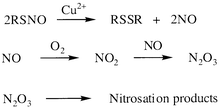Nitrosation products from S-nitrosothiols via preliminary nitric oxide formation
Abstract
High yields of N-nitroso-N-methylaniline were obtained from S-nitrosothiols (RSNO) and N-methylaniline in water at pH 7.4. Reactions were completely inhibited by the presence of EDTA and also when oxygen was removed from the solutions. Lower yields of 4-nitrosophenol were obtained from phenol under similar conditions and there was strong evidence of the rapid formation of a nitroso product (absorbance maximum at 390 nm) from uric acid which decomposed more slowly under the reaction conditions and could not be isolated. The results are consistent with prior nitric oxide formation, by the well-known Cu2+-catalysed (in which the active reagent is Cu+) decomposition of the S-nitrosothiol, subsequent oxidation of NO yielding NO2, which reacts further with NO to give N2O3, which then effects conventional electrophilic nitrosation in direct competition with its hydrolysis to nitrite. With phenol as the reactant, higher yields of 4-nitrosophenol were only possible when there was a very large excess of phenol over RSNO, probably due to the more effective relative competition of the hydrolysis reaction, given the lower reactivity in nitrosation of phenol compared with N-methylaniline. Nitrosation of uric acid is unknown, but we were able to observe the fairly rapid build-up of the same absorbance at 390 nm, from uric acid and nitrous acid only at around pH 4, which disappeared more slowly. The results suggest that uric acid behaves as do amides generally in that a nitroso compound is formed, which decomposes by an acid-catalysed route.


 Please wait while we load your content...
Please wait while we load your content...